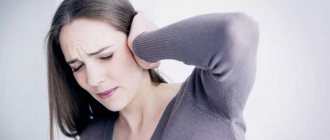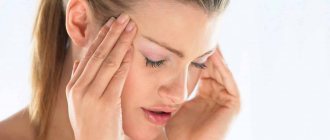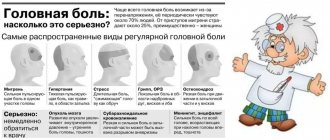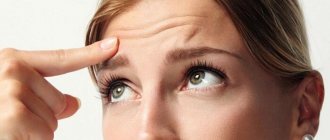Cluster headache is a pathology with pronounced painful sensations, grouped mainly in the area of the eye, eyebrow and temple (on one side).
This type of headache is directly related to the trigeminovascular system, that is, the trigeminal nerve and innervated vessels (from the Latin nervus trigeminus - trigeminal nerve).
In general, headache is one of the most common nonspecific symptoms of various diseases and pathological conditions.
To simplify diagnosis, neurologists divide headaches into four types:
- tension headaches (the most common type of headaches, occurring mainly against the background of nervous or physical stress);
- migraines;
- chronic headaches (over the past three months the patient has experienced at least 4 times a week);
- cluster headaches (cluster headache).
Along with the above division into types, there is also a general classification of types of headaches .
Cluster pain is considered the rarest and most severe type of headache. According to official medical statistics, cluster headache occurs in 0.1-0.4% of the population.
Cluster headache - what is it?
Cluster headache is the most severe form of headache, manifested by periodic recurrent attacks. Other names for the pathology are often used: cluster headache, Horton's migraine.
Cluster headache manifests itself as a series of headache attacks over a limited period of time (from 1-2 weeks to 1-2 months) followed by a long period of remission of the disease (sometimes cluster headaches disappear for several years).
For reference. A characteristic feature of cluster headaches is the strength and intensity of the pain syndrome. The severity of the headache is so severe that among patients with cluster headaches, cases of suicide have been recorded in order to get rid of the pain.
Cluster headaches occur predominantly in men (in women they are recorded 4 times less frequently).
The onset of the disease in men is observed at 20-29 years of age. In women, two peaks of incidence are noted (from 15 to 20 and from 45 to 50 years).
Treatment tactics
Treatment of cluster headache is a pressing issue that is being actively studied in modern neurological practice. Optimization of treatment regimens and principles allows you to achieve lasting and effective results. At the moment, there are two independent and mandatory treatment approaches for each patient. The first approach is analgesic symptomatic therapy aimed at symptomatic treatment, i.e. relief of an acute attack of cluster headache. The second principle is preventive treatment to prevent recurrence of a series of attacks of cluster pain. Unfortunately, it is currently impossible to completely cure the disease, however, with supportive corrective therapy, lasting results can be achieved.
Anesthesia
Analgesic therapy consists of prescribing potent analgesic drugs with a central mechanism of action. Such drugs belong to the group of narcotic drugs and are used only for treatment in a hospital setting. The use of pure oxygen has also shown high effectiveness in relieving an attack of cluster pain. During an attack, the patient is given 100% oxygen by inhalation, which reduces the intensity of the pain syndrome.
Prevention
Prevention of cluster headaches involves the use of complex therapy aimed at improving the rheological properties of the blood, maintaining the cardiovascular and nervous system, as well as the use of glucocorticosteroids.
They use drugs from the group of angioprotectors and neuroprotectors, which significantly increase the metabolic activity of the brain and prevent dystrophic disorders in the central nervous system. Lithium preparations are also used to improve the functioning of the hypothalamic-pituitary system and normalize electrochemical and neurotransmitter processes in the brain.
Clinical Brain Institute Rating: 3/5 — 12 votes
Share article on social networks
Cluster headache - causes
The exact causes of cluster headaches are unknown. The hereditary nature of cluster headaches can be traced only in 2.5-4% of patients.
Also, most experts are inclined to believe that the leading role in the development of attacks of cluster headaches is played by the pathological activity of the hypothalamus.
However, the most common are:
- drinking alcohol;
- insomnia;
- use of certain medications (for example, histamine administered subcutaneously or intravenously, sublingual forms of nitroglycerin);
- psycho-emotional or nervous stress.
Risk factors
It should be especially emphasized the variety of risk factors that provoke cluster headaches - they are different for all patients.
When cluster headaches associated with drinking alcohol occur, the amount of alcohol consumed does not matter. The development of such headaches is not prevented by drugs that are effective for cluster headaches.
In this case, alcohol acts as a provoking factor only in the cluster period; during the period of remission of the disease, drinking alcohol does not lead to the development of an attack.
For reference. Alcohol-induced cluster headaches are thought to be related to the vasodilatory effects of alcohol.
Medications (histamine, nitroglycerin) can also provoke cluster headaches due to their vasodilatory effects.
Sometimes the development of cluster headaches is facilitated by an increase in serotonin levels (together with histamine, serotonin is responsible for regulating the human biological clock).
Cluster headaches associated with overexertion can occur after watching TV, working at a computer or smartphone for a long time, after an intense workout, stress, or lack of oxygen (staying in a stuffy, unventilated room).
The influence of testosterone levels on the frequency of attacks is also considered (increased testosterone levels can act as a provoking factor).
In some patients, cluster pain may occur spontaneously and have no connection with provoking factors.
Personality characteristics
Men more often suffer from cluster headaches, which is why it is also called “male migraine”, although in general the stronger half are less susceptible to cephalalgia (headache). This may be due to the fact that men drink alcohol more.
A specific feature of cluster headaches in men is that most patients have common constitutional and personality traits:
- high growth;
- developed muscles;
- square lower jaw;
- presence of a dimple on the chin;
- light eye color;
- overambitiousness combined with indecisiveness or excessive impulsiveness.
More than ninety percent of patients with cluster pain smoke heavily (1-1.5 packs of cigarettes per day).
Characteristic features of patients
Cluster headaches most often occur in men of reproductive age from 20 to 50 years. All people suffering from this pathology report a very high intensity of pain. Many people focus on the fact that unbearable pain gives rise to the desire to commit suicide. In practice, there are many cases where patients, in a fit of despair, were on the verge of losing their minds and banging their heads against the wall.
Crisis situations are often short-lived, but the pain is so strong that a person develops fear of a new attack. Over time, addiction develops, but it is not associated with a decrease in pain, but with the fact that a person simply learns to adapt to attacks.
Usually, at the initial stage, when pain manifests itself locally on one side of the face, pain-relieving measures are immediately taken, which must be agreed upon with the doctor. Cluster pain can cause irritability and aggressiveness.
Recently, experts have identified the characteristic features of patients suffering from cluster headaches. As it turned out, these are men with large physiques and smoke more than a pack of cigarettes a day.
Biorhythms and cluster pain
It is believed that cluster headaches (cluster cephalgia) are associated with human biorhythms (biological clocks). This theory is supported by the fact that cluster headaches (during the cluster period of the disease) develop predominantly at the same time of day (most often cluster headaches occur at night, during the REM sleep phase).
Normally, due to the normal functioning of the human biological clock, the body's enzymatic activity, hormonal secretion, physiological reactions and processes are regulated.
The hypothalamus regulates the biological clock. When the hypothalamus is malfunctioning, excessive activation of the central nervous system and dilation of the blood vessels in the brain can occur.
For reference. The basis of cluster headaches is precisely the excessive filling of the brain vessels with blood.
Also, low levels of melatonin or a sharp increase in the level of serotonin and histamine in the blood can provoke excessive dilation of cerebral vessels.
Pathogenesis of development
The exact pathogenesis of cluster headache development is unknown.
The triggering factor for the development of an attack is a number of biochemical, metabolic and hormonal changes in the body associated with disruption of the hypothalamus.
The cluster (pain) cycle can also be triggered by the following trigger factors:
- change of time zones (long flights, moving);
- sleepless nights, disruption of physiological sleep patterns;
- psycho-emotional overload;
- watching TV for a long time.
The duration of a cluster headache attack is from 15 to 180 minutes, up to 8 times a day. Cluster periods last from 7 to 90 days and may disappear for several years.
PET (positron emission tomography) scans of patients with cluster headaches show hyperactivation of gray matter cells in the posterior hypothalamus.
Disruption of the hypothalamus leads to dilation of the ophthalmic artery and the proximal part of the ICA (internal carotid artery), as well as cerebral vessels.
At the same time, there is an increase in the level of “painful” neuropeptides in the blood and hyperactivation of the trigeminal cranial nerve (namely, its 1st branch - the ophthalmic nerve).
Involvement of the first branch of the trigeminal nerve in the pathological process leads to the fact that in addition to headache, a cluster attack is accompanied by:
- drooping eyelid (ptosis),
- pathological constriction of the pupil (miosis),
- lacrimation,
- nasal congestion.
For reference. All these symptoms appear only on the affected side (the attack of cluster headache is unilateral).
Cyclicity of cluster cephalgia
The cyclicity of cluster pain can vary. It depends on the individual characteristics of the body and the causes of the disease.
The following types of cephalalgia of this type are distinguished:
- chronic attacks
- occur several times a year, and the duration of remission does not exceed one month; - episodic attacks
- characterized by irregular occurrence: periods of remission can last several months.
The duration of attacks rarely exceeds an hour. Most often the pain goes away within a quarter of an hour. But at the same time, longer attacks are always characterized by less intense pain. Inappropriate behavior can only be provoked by short-term attacks.
It is noteworthy that at the initial stage of development of cluster headaches, they occur with a certain frequency for 2-3 months. After this, remission can last for a year. If the disease is not treated, it becomes chronic, and the intervals between attacks decrease. In the chronic course of the disease, remission rarely lasts more than a month.
Types of cluster headaches
Cluster pain is divided according to the frequency of attacks, since the symptoms of the disease are always the same.
Cluster headache can be:
- episodic (registered in 80-90% of patients with cluster headache). Patients experience more than two cluster periods (their total duration usually ranges from 7 to 90 days, between which remissions of more than 1 month are recorded);
- chronic (occurs less frequently, in 10-20% of patients). A characteristic feature is the absence of remissions or their duration of less than a month, as well as frequent resistance to treatment.
It should also be noted that episodic cluster headaches may disappear for several years.
Pay attention to how to distinguish a cluster headache:
- comes unexpectedly and rapidly intensifies;
- the attack lasts about an hour;
- an attack may occur during sleep, before waking up;
- the attack may be accompanied by nervousness and agitation;
- pain always occurs on the same side;
- It is almost impossible to predict an attack; it is not influenced by external factors. After the attack there comes relief and a feeling of fatigue.
Risk group
Due to the huge number of reasons that lead to cluster headaches, many categories of people may be at risk. First of all, the danger of this type of cephalgia arises if a person’s biological clock is disturbed, which often manifests itself as insomnia.
The risk of cluster headaches increases in men aged 40 years. As for women, in whom pathology is observed much less frequently, age after 60 years is critical.
The risk group includes people who abuse alcoholic beverages. Smoking also often causes an attack of this type of cephalalgia. But, on the other hand, cluster headaches often occur when quitting smoking abruptly.
The risk group includes people with a family history. If any of the relatives in the family suffered from attacks of this type of cephalalgia, then this pathology is usually transmitted through the male line.
Cluster headache - symptoms
Cluster headaches always occur acutely. The peak of pain is observed within 1-3 minutes after the onset of the attack.
The average duration of a cluster headache attack can range from 15 minutes to an hour (less commonly, the duration of an attack can reach 1.5-2 hours).
The pain attack stops as quickly and suddenly as it begins.
As a rule, cluster attacks occur in series (bundles, clusters). A patient may experience from two to four attacks per day (less often about 6-8 attacks).
For reference. Cluster headaches usually occur at night. The period of a typical cluster exacerbation of the disease can last from two weeks to two months.
Specific symptoms of cluster headache:
- the pain is one-sided (more often the pain attack is localized on the left side);
- burning or stabbing pain, unbearable;
- the epicenter of pain is in the eyeball (patients describe the pain as “a feeling of the eye being squeezed out from the inside”, “a knife blow to the eye”);
- pain can radiate to the cheek, cheekbone, ear, teeth;
- pain intensifies with pressure on the splenius muscle, trapezius muscle;
- in rare cases, pain may affect the neck and shoulder area;
- pain is accompanied by drooping of the eyelid, lacrimation, nasal congestion, constriction of the pupil (less commonly, dilation of the pupil), and the flow of mucus from the nostril on the side of the pain syndrome.
Increased salivation, sweating, photophobia, fear of sound, and vomiting may also occur.
For reference. A specific feature of a cluster attack is also the inability to maintain a horizontal, motionless body position. Patients rush around the room, hitting objects, beating the wall with their fists.
At the same time, increased physical activity can contribute to faster relief of a pain attack.
Secondary headaches
Cluster headaches can be not only primary, but also secondary, i.e. pain syndrome can accompany various diseases. Pain is a symptom of carotid aneurysm, vascular dystonia, or cerebral infarction. Very often, attacks begin after traumatic brain injuries that disrupt the structure of the brain.
This type of cephalgia may indicate the development of severe pathologies if the pain is accompanied by other symptoms:
- Vomiting, nausea, impaired speech function, loss of consciousness, partial paralysis indicate the possible development of an ischemic stroke or cerebral hemorrhage.
- Drowsiness and weakness along with a decrease in pain, as well as the lack of adequate reactions to what is happening, indicate a disturbance in brain activity after injury.
- Fever accompanied by increased neck muscle tone indicates possible meningitis.
- Increasing headaches during exercise, as well as when coughing and sneezing, warns of possible cerebral edema.
- Prolonged throbbing pain in the orbital area indicates the development of glaucoma.
Primary headaches
Cephalgia is considered primary if it is not provoked by another more serious disease. This type includes cluster or beam pain, neuralgia, migraine. The nature of these pains is specific:
- Migraines are accompanied by weakness, photophobia, and nausea. The attacks are pulsating in nature and last from 3 hours to several days.
- Neuralgia is accompanied by shooting, stabbing pains that occur up to hundreds of times a day. Typical signs: redness of the eyes, sweat on the forehead, tearing.
- Cluster pain differs from migraine in the behavior of the patient. With a migraine, the patient wants to lie down, fall asleep, be alone, and avoids extraneous noise. During outbreaks of cluster cephalgia, a person does not find a place for himself, walks in circles around the room, and runs out into the street. During an attack, a person who is ill cannot sit quietly, do normal activities, or sleep. He becomes agitated, irritable, and aggressive.
Diagnosis of cluster headaches
Diagnosis of cluster pain presents significant difficulties, since despite the specific clinical picture of the disease, to make this diagnosis it is necessary to exclude all other causes of headache.
For reference. There are no specific tests to confirm this diagnosis.
To establish a diagnosis, the patient is prescribed:
- general blood and urine tests;
- biochemical blood test + lipid profile;
- coagulogram (test for blood clotting);
- CT, MRI, PET scan of the brain (sometimes with contrast enhancement of cerebral arteries);
- Ultrasound of cervical vessels;
- examination of the fundus vessels;
- polysomnography with electrooculometry, electroencephalography, ECG, mometry, assessment of blood saturation with oxygen and carbon dioxide.
The patient should be examined by a neurologist, psychiatrist, ophthalmologist, and angiosurgeon.
Cluster headache - treatment
Since the exact causes and pathogenesis of the disease have not yet been studied, etiotropic therapy for the disease has not been developed.
All drugs used for cluster headaches are aimed at:
- relief of a developed pain attack;
- reducing the duration of the cluster period;
- reducing the frequency of attacks in the cluster;
- prevention of the development of new attacks;
- increasing the duration of the remission period.
Triptans are used to eliminate an attack of cluster cephalgia. Patients for whom triptans are contraindicated are prescribed inhalation of 100% oxygen and applications of local anesthetics to the nasal mucosa. In rare cases, ergot preparations may be used.
For reference. At the moment, triptans and inhalation of 100% oxygen are considered the most effective methods for relieving a pain attack.
In some cases, intense physical activity combined with deep breathing can help relieve pain.
Less commonly, nasal drops with lidocaine, somatostatin, ergotamine, and verapamil are used to eliminate a painful attack.
In 2021, the FDA also registered the gammaCore non-invasive device, which reduces the intensity of a pain attack through active electrical stimulation of the vagus nerve fibers. In controlled studies of its effectiveness, the device showed a significant reduction in the duration and intensity of attacks.
However, the use of gammaCore has a number of significant limitations (high blood pressure, heart rhythm disturbances, the patient has a pacemaker, metal implants in the neck).
Surgery
A surgical approach to the treatment of cluster headaches is used in cases where drug therapy is ineffective.
Use:
- suboccipital block;
- transcutaneous neurostimulation of the greater occipital nerve;
- stimulation of the hypothalamus;
- radiofrequency thermocoagulation of the trigeminal ganglion;
- radiofrequency trigeminal rhizotomy.
Treatment at the Energy of Health clinic
Even a mild headache can affect lifestyle and be a symptom of serious illnesses. Doctors at the Energy of Health clinic invite you to undergo a comprehensive examination and identify the cause of the discomfort. We offer modern, combined treatment methods, including:
- drug therapy according to indications;
- various types of physiotherapy;
- group and individual physical therapy classes, compiling sets of home exercises;
- therapeutic and general massage;
- manual therapy and osteopathic services if necessary;
- therapeutic procedures for sinusitis and other diseases of the ENT organs;
- ophthalmological care, etc.
Working together with the patient, we will find the cause of the pain and try to eliminate it as quickly as possible.
Complications
Most often, treatment complications arise from excessive consumption of headache pills. This can happen if the resulting headache was perceived as normal and measures to eliminate it were taken “as always.” The pain does not go away and the pills are used again.
Attention. Frequent use of medications for headaches is contraindicated for all categories of people.
Abuse of painkillers and oxygen therapy may result in an overuse (medicinal, rebound) headache.
It appears when trying to stop painkillers. A provoking factor in the occurrence of abusive pain is the habit of drinking analgesics “for future use,” as well as drinking alcohol simultaneously with medications.
Cluster headaches can also seriously worsen the psycho-emotional state of patients. In some cases, the help of a psychologist or psychotherapist is required.
Seizure prevention
Prevention consists of avoiding provoking factors during the cluster period.
Can also be used:
- verapamil drugs (proven to reduce the frequency of attacks);
- angioprotective agents;
- neuroprotectors that improve the activity of metabolic processes in brain tissue;
- drugs that improve the rheological properties of blood.
Preparations of glucocorticosteroid hormones and antiepileptic drugs are used less frequently.
Additionally, patients are recommended to completely quit smoking, normalize physical activity, as well as sleep and rest patterns.
Hypnotherapy, as a method of psychotherapeutic treatment, is one of the most effective ways to get rid of various types of addictions and neuroses. Hypnosis was successfully used to treat alcoholism at the beginning of the 20th century by Russian psychiatrist and neurologist Vladimir Bekhterev, the grandfather of Natalia Bekhtereva, a Russian neurophysiologist and head of the Brain Institute.
To prevent the occurrence of cluster periods, medications with a vasodilating effect should be taken only under the supervision of a physician. To prevent night attacks, you should adhere to a sleep schedule and, if possible, limit yourself from stress overload.









